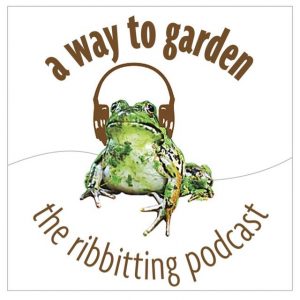I CONFESS to something of a weakness for Japanese maples, and I suspect I’m not alone. Now, thanks to breeding work by experts like today’s guests, there are more and more varieties being made available that are suited to a widening range of climate zones and garden conditions, meaning the circle of maple lovers can keep on growing.
Brothers Matt and Tim Nichols are the forces behind MrMaple dot com, a North Carolina-based retail mail-order nursery with a staggering collection of about 1,500 different Japanese maple varieties to offer. They ship 100 trees a day year-round, as many as 700-plus a day in peak season. As if that were not enough, last fall, the Nichols Brothers acquired an esteemed wholesale nursery in Oregon, Buchholz & Buchholz. Now, they’re selling to garden centers, too.
I welcomed them to the podcast to talk about these irresistibly collectible trees, including ones like ‘Purple Ghost,’ pictured above.
Read along as you listen to the April 8, 2024 edition of my public-radio show and podcast using the player below. You can subscribe to all future editions on Apple Podcasts (iTunes) or Spotify (and browse my archive of podcasts here).
 japanese maples, with the nichols brothers
japanese maples, with the nichols brothers
Margaret Roach: Hi, Tim [above, left]. Hi, Matt [right]. How are you?
Matt Nichols: Hey, thanks so much for having us. Man, if I ever I’m having a bad day, I’m going to go back and listen to that. I feel pretty cool. [Laughter.]
Tim Nichols: Margaret, thanks so much for having us. It’s a pleasure to be on your podcast.
Margaret: Oh, well, we just did a “New York Times” garden column together after I learned about your expansion and purchase of Buchholz & Buchholz. But I was first introduced to you years ago by our mutual friend, Tony Avent of Plant Delights Nursery, who’s a big fan of yours, so I think we should do a shout-out to Tony to thank him for introducing us originally.
Matt: Oh, big shout out to Tony. He’s a huge mentor of ours and just a huge influence on us.
Tim: He has really taken us under his wing when we were very small and really helped us on the business side of things. It was always fun because we would go to his nursery, talk about plants at Plant Delights Nursery, and then we’d go out to dinner and we’d do nothing but talk business. And so, it’s always been a fun friendship and mentorship with Tony Avent for sure.
Margaret: He’s taught me a lot, too, and he continues to always have great suggestions, introduce me to people. I mean, I’m just completely grateful. So shout-out, Tony.
So maples: The origin story of what’s now MrMaple is kind of a fun one, and you grew up with maples being a thing on both sides of your family, and your father had a hobby business with Japanese maples. It was like you were destined to become a pair of MrMaples, huh [laughter]? Tell us sort of the brief version of that.
Tim: Our grandmother started growing Japanese maples in the 1950s. She was sort of one of the people, a pioneer, who grew Japanese maples, never meant to sell them, and then people would come and started asking her, “Hey, can I buy these?” because she had them lined out in rows. They started getting tighter and she said, “Sure,” and she tagged everyone in between and started selling Japanese maples in the 1950s.
My Dad officially started Nichols Nursery from the other side of the family about 50 years ago, and that was what morphed into MrMaple today. And so, we actually got it from both sides of our family, our mother’s side with our grandmother growing Japanese maples and our dad’s side who started growing Japanese maples before he ever met my mother.
Margaret: That’s crazy kind of, isn’t it?
Matt: It’s wild. We’ve done this our whole lives. Tim and I grew up going to flea markets. They weren’t even called tailgate markets back then or farmer’s markets, that hadn’t really hit the South yet. We just called them flea markets. We would go to high-end flea markets and sell Japanese maples, balled and burlapped, and things like that growing up, and it’s just something we always did.
If you’d asked me when I was 12, if I’d be doing this for a living, I’d have laughed at you, because this was my busy work with Dad, getting out and potting up all the rootstock. Our father taught himself to graft and just became a little bit of an aficionado for maples for himself just as a hobby. He worked at a factory and this was his way to get out and forget about the day-to-day work and enjoy himself.
Around 2008, Tim and I started taking it a little bit more seriously and Dad said, “Well, you guys are going to take all the fun out of it and make it work.” [Laughter.] I guess we made it more of a career rather than a fun hobby that we were pursuing.
Margaret: Oh, my goodness.
Tim: The crazy thing is now MrMaple has really been blessed and we really grew so much that now we recently purchased Buchholz Nursery, and he purchased the grounds from J.D. Vertrees’ family. J.D. Vertrees wrote the book on Japanese maples. And so, here we are from this real small family nursery to now purchasing this historic nursery at Buchholz Nursery, and it seems like everything’s just came full circle.
Margaret: No, legacy; it’s great, the hand-me-down. And I love that about gardening in general: the provenance of things and the pass-along, and it’s just the generations.
Let’s talk about the plants. There’s such an incredible diversity of tree shapes and habits of the trees, the sizes of trees in Japanese maples, leaf color, oh my goodness, texture, scale of leaves, and on and on and on to choose from. When we did the “Times” column, you told me that, however, despite all that potential diversity, there’s sort of two archetypal versions that gardeners mostly buy [laughter]. What are those?
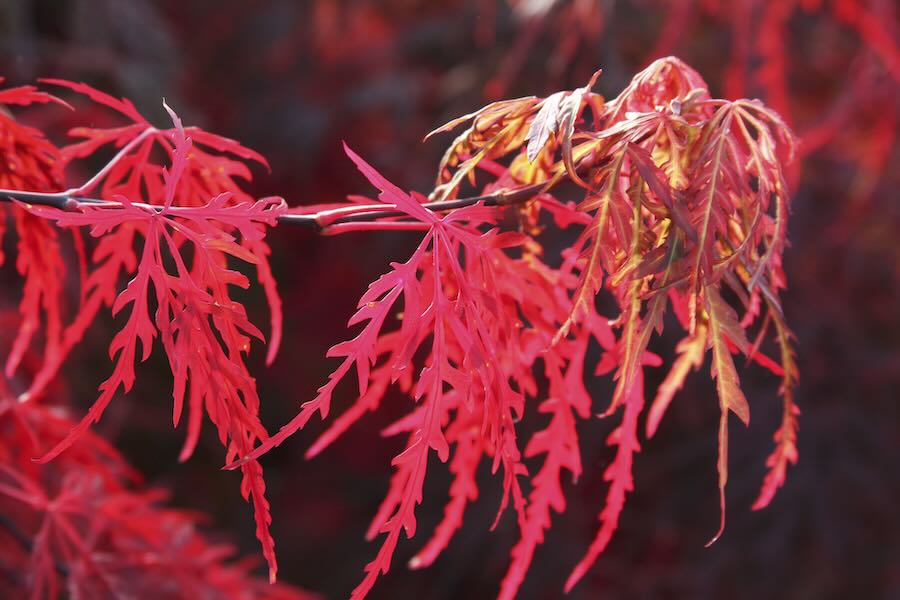
Tim: That’s one of the things about Japanese maples. They’re kind of like potato chips, you can’t have just one. Whenever you get one, you get addicted to how beautiful they are, and you start thinking, “I’ve got all these other spaces in my garden. What else can I put in these spaces?” when they realize there’s so much diversity in Japanese maples. There’s a Japanese maple for nearly every spot in the garden.
Margaret: I mean, some of them, as you were saying, are weeping, some are upright. There are different sizes, the colors of the foliage. I mean, gold and green and kind of dark red colors and pinkish colors and I mean, variegated and splashed and splotched and edged. There’s a lot of colors, and the fall color that you can get out of them is astonishing.
Matt: I understand it can be quite overwhelming for people getting into Japanese maples. There’s so much diversity going on there and so many interesting things. We try to make it easy sometimes by curating a collection a little bit of different types. Maybe we’ll list something that has one specific variegated pink and white type with a couple yellows and a few cool dwarfs. We’ll pick a few things from each category and curate it a little bit, because it can be a little overwhelming to get into a hobby and know there’s 1,500 different varieties of this one thing.
Some people are completionist, so they try to get all of them so that can be quite frustrating, too, I’m sure. But there’s so many interesting nuances to them from the color to the leaf shape, to the texture to the fall colors. You really can continue to just explore and find new ways to match them. Now, we tend to mass-garden with Japanese maples, so we’ll end up planting things near each other that are both maples, but we’ll use diversity of color, height, and then fall color. That way they change a little bit each season so maybe that yellow and that red are going to play off each other during one season, but then that orange and then a deeper red or a more crimson fall color will play off each other during a different season.
Margaret: Before I talked to you guys for the “New York Times” article, I didn’t even know, for instance—although I guess in my head if you had asked me, I would’ve said, “Yeah, that sounds right”—I didn’t even know until you told me that laceleaf types are usually weeping forms, but there are exceptions. But that’s a typical combination, laceleaf and weepers.
Tim: Yeah, that’s so true. Laceleaf and weepers are typically just that cascading umbrella habit that you get out in the landscape, and that’s what a lot of people start out with. There are exceptions, though, that have that palmate leaf and weeping habit. And then, there are some exceptions that have more an upright habit, like ‘Seiryu,’ a very, very popular tree that’s very vigorous and upright. But that’s pretty rare is getting a laceleaf upright. That’s something that you don’t see too frequently.
It’s the main thing with people whenever they’re starting out with a Japanese maple. One thing I just want to get out to everybody is figure out the tree for the right spot in the garden. With so much diversity, go and look and see what size you have. Think about your 10-year expectancy of height and width, and then find a tree that fits that space, because there’s so many amazing plants that can do that. If you’ve got good drainage and you’ve got that height and width thing figured out, you’re going to have a tree that will do really beautiful out in your landscape.
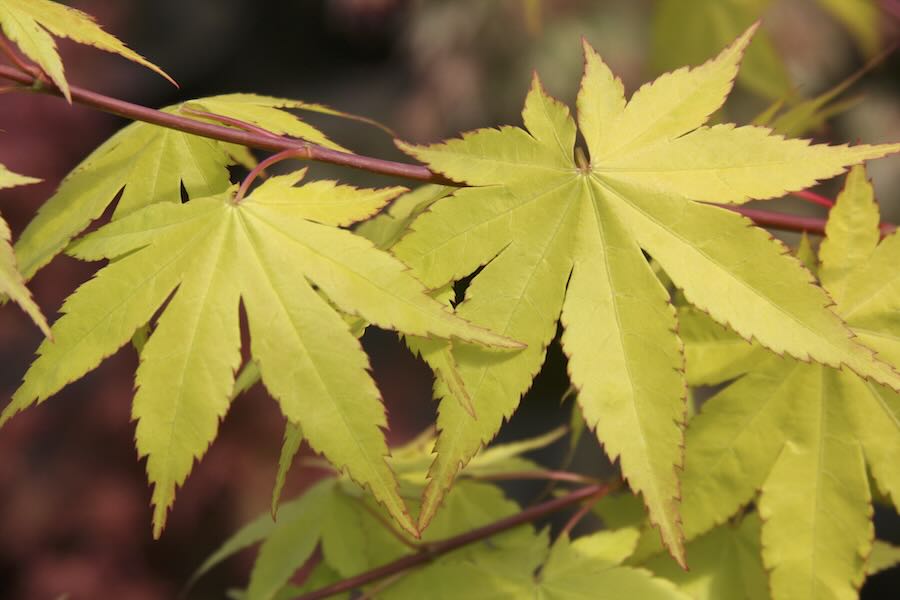
There’s so many different sun exposures in different areas. We’re in the mountains of western North Carolina where our nursery’s at, so we get by with more things in full sun than people, say, in northern Florida or something like that. There can definitely be different heat-index tricks to that.
Now, Japanese maples, in general, are going to work in Zones 5, and then we say on the East Coast up to Zone 9, but zones are really rated by how cold, but it is a good generalization on the East Coast. And then, there’s a ton that can handle full sun. Now, ones that want to avoid sun, in general, are more pink and white Japanese maples. The more pink and the more white you have in your leaf, typically those are going to need some more late-day shade.
Again, there’s always exceptions to the rule. Yellow can kind of go into that category, too, where, in general, if it’s a very bright yellow leaf, you want to give that some more 12:00-on protection or 2:00-on protection, depending on the area. You’re getting those leaves to look their best even in the summer, protecting them to have the best fall color possible, and that’s a good generalization. But again, rules are always made to be broken with horticulture. There’s always some that kind of go outside the box and do a little bit different. [Above, ‘Summer Gold.’]
Margaret: Right. As I said in the introduction, you guys in collaboration, in some cases, with Mr. Buchholz, whose nursery you recently purchased, you guys have been working on stretching that a little bit, too, making some hybrids that can bring the color pink into slightly warmer zones or the color gold, haven’t you? Isn’t that sort of what people are working on, stretching the zones, or the versatility of some of these plants?
Tim: That’s for sure. With, for instance, Acer palmatum ‘Geisha Gone Wild’ [below] was developed at Buchholz Nursery, found as a sport on the cultivar ‘Geisha,’ it can handle more sun than most of your pink-on-red selections. An excellent tree in Zone 8, can handle a little bit more sun than many of your other pink and red variegated types.
And then, we’ve actually been working here at MrMaple on developing hybrids with Acer oliverianum, which part of our Heat Seeker Series that allow us to go even into much hotter zones. We’ve got some oliverianum hybrids that can handle full sun in Texas. And so, it’s one of those fun things where you start developing something and you start seeing that some of these species have “superpowers” that allow you to push the zones on Japanese maples.
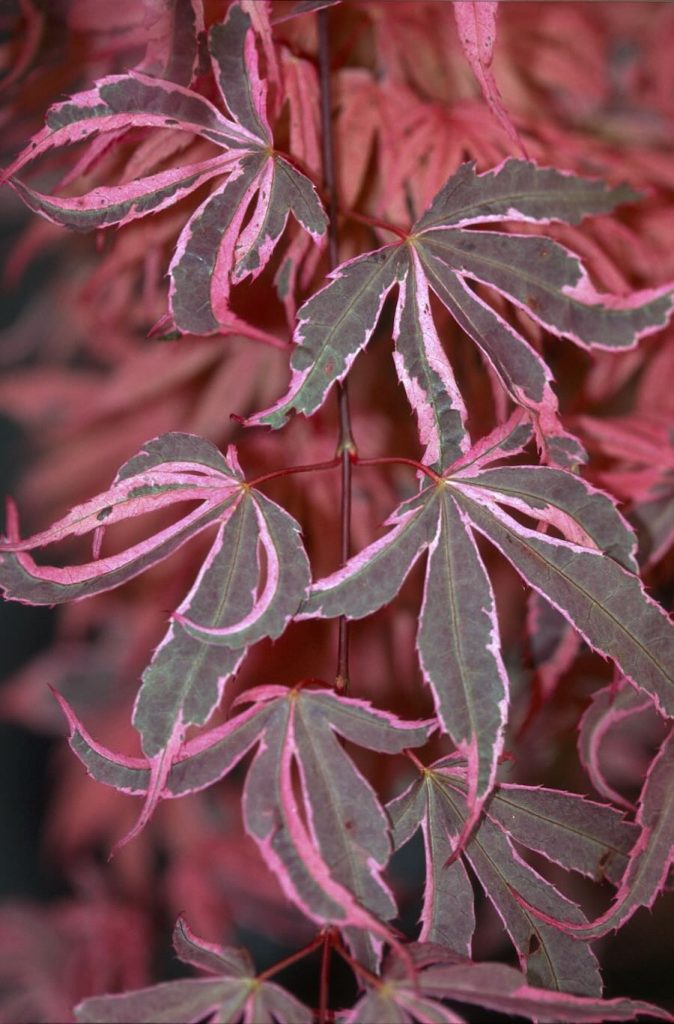
Matt: For sure.
Margaret: What about the coral bark? There’s that famous one, ‘Sango Kaku,’ and there are others. What about the coral barks? Are there places they do and don’t like to be?
Matt: Yeah. We recommend this one typically to Zone 6. We’re 6B here in Western North Carolina, and most of your coral bark do have a little bit thinner cambium so Zone 5 can be stretching it, although I’ve seen some beautiful specimens in zone 5. Zone 5 can be a little too harsh in the extreme winters for the coral barks. They tend to work Zone 6 and up, and are just exceptional plants.
They do tend to be very receptive to warmer climates. Dryness is really the key there. They don’t want to be boggy or wet feet at all in any of the bark-interest types. Soggy during the winter can be one of their detriments. They kind of like warmer spaces that are a little dry. They can actually handle a good bit of sandy soil as well and be very resistant to that. The main thing is not wet and too cold.
Tim: We have seen some of our Acer pseudosieboldianum hybrids we’re working with starting to get some bark interest, like lighter yellow-green colors, and we’re hoping that one day that we can get some coral-bark selections of those Acer pseudosieboldianums to push it down into Zone 5 and maybe Zone 4 with the Acer pseudosieboldianum species [below]. We’re working not just on the heat-tolerance side, but also trying to expand things on the cold-tolerance side as well.
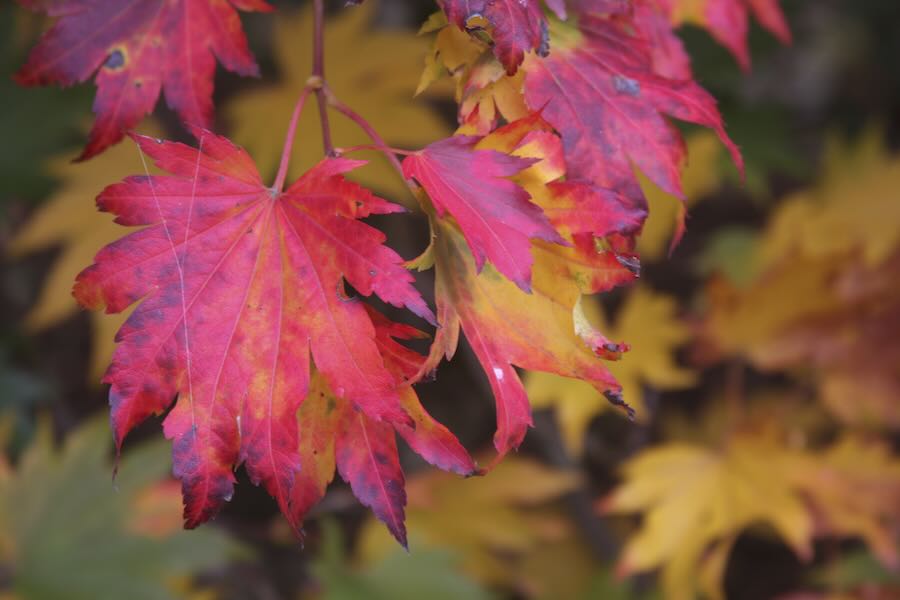
And so, I had a big one in the ground for many, many, many, many years, and it finally croaked, and who knows why. Some soil-borne problem, I think. But that is an exceptionally hardy plant and the fall foliage is beyond, I mean, just absolutely extravagant, fiery, and wonderful. I’m so excited to hear that it’s becoming part of the sort of breeding formula for a new generation of maples. That’s great because it’s a great plant, and yet I didn’t know many people who knew it, even.
Matt: For sure. Talon Buchholz had started a whole program before we had actually taken over there. Before he knew we were even interested, he’d actually shared his whole series of seedlings with us. And so, I think there’s some groundbreaking ones there that have a lot of red to them as a pseudosieboldianum, some different color patterns, things that are going to be hybrids with palmatum likely to give them some more ornamental traits.
But the goal is that once they are tested, that pseudosieboldianum trait will allow them to go into Zone 4 and be even a little bit more climate-pushing for some of the colder zones, and just more all around cold-hardy, so that when we do get those crazy polar vortexes, you’re a little more protected.
Tim: Speaking of those polar vortexes, the Acer shirasawanum hybrids that Talon Buchholz actually developed and introduced through Buchholz Nursery have actually proven to be more cold-tolerant than many of the just straight palmatums during those polar vortexes. Many in Zone 5 talked about how their red Acer shirasawanum mix from Buchholz have done really well. For instance, ‘Shira Red,’ one that’s similar, ‘Red Dawn.’ There’s a number of Acer shirasawanum hybrids and people often said, “What’s so great about these?” And then, when the polar vortexes hit, they said, “Guys, these are amazing.”
Margaret: This is what’s good about them [laughter]. Because of the worry about the hardiness and so forth, and it isn’t even the hardiness, it was more that the damage that would be done by one of our northern winters, I think. It wouldn’t necessarily kill the thing, but it beat it up so bad in some of the cases.
Earlier on, when I started buying them years ago, and maybe I only have 10 or 12 or something, but they’re in pots, and I wheel them on hand cart into the garage every winter. It’s unheated, but it keeps them out of that sort of ice and wind mess. But now, of course, I understand that they probably would be fine outside. But again, nobody really knew way back when, decades ago, up here, it wasn’t really the common thing. ‘Bloodgood’ was around and a couple of weeping cutleaf types, laceleaf types, but you really didn’t see much diversity of choices. I bought mine mail-order or something and just put them in a pot and tried them.
That’s another way to grow them. I think they’re gorgeous as pot specimens, and they can live a really long time that way.
Tim: Oh, for sure.
Margaret: Now, I shouldn’t then take it out of the pot and expect it to do well planted in the ground after it’s been bonsai-ed, so to speak for so long [laughter]?
Matt: No. A lot of times they’ll take off.
Margaret: Oh, they will?
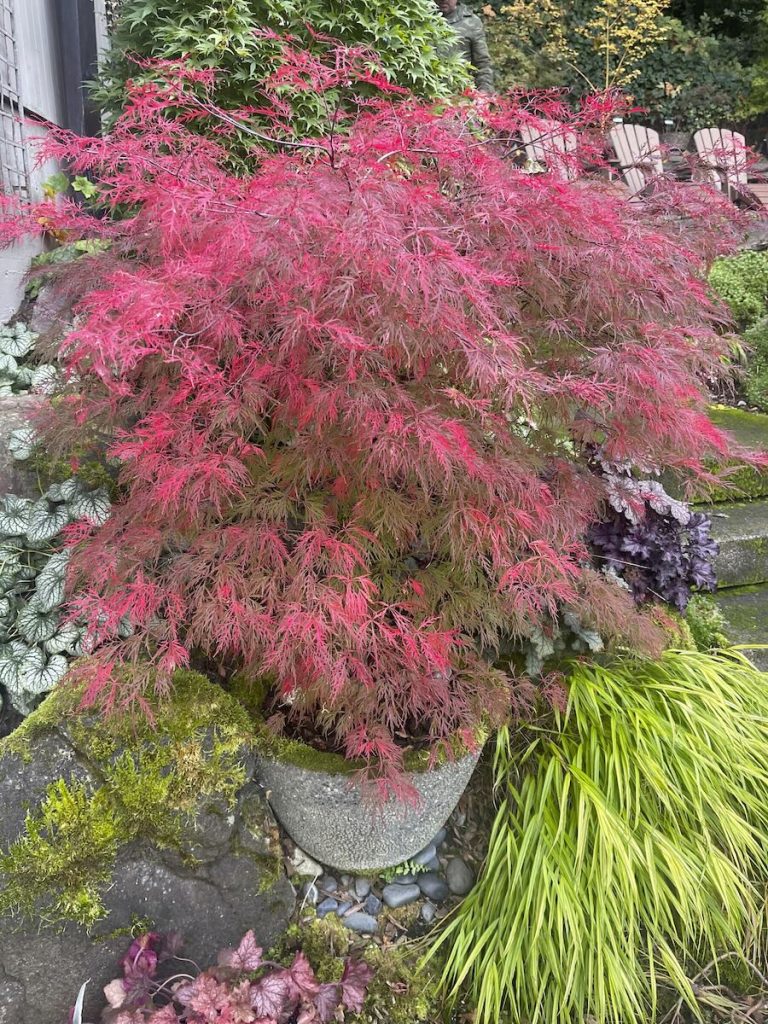
A lot of times, a lot of those trees that have been in a big container for quite a while, once they do get in the ground, they tend to leap. People will say, “Well, how long can a tree be in a container?” Sometimes I’ll show them some 20-year-old specimens here at the nursery and they’ve never been in the ground. They can be in a container for quite a while as long as you’ve got good drainage.
I tend to protect in Zone 5 when they’re outside. I think sometimes, especially where I’m at, people are overly protective and they’re better off leaving their tree outside in a Zone 6 for most winters, even in a container.
But my experience most of the time is they tend to leap [laughter] when they finally do get some room to spread out their roots in the ground. [Above, Acer palmatum ‘Raraflora’ in a container.]
Margaret: When you set them free.
Matt: Yeah. Like, “Thank goodness, we can the soil running.” [Laughter.]
Margaret: I mean I definitely have some that are close to 20 years old, but they’ve been moved up. I’ve stepped them up. Over their first few years, they got stepped up in pots: bigger, bigger biggest giant pots, but I don’t have any pots that are any bigger anymore to put them in.
Any other tips? One of you mentioned good drainage, and that’s a universal rule with Japanese maples is no swampy site. That’s one of the reasons I think you told me when we did the “Times” article that growing them in pots really does work, because it gives them that sharp drainage. Any other feeding, no feeding, watering things, when to prune, anything else that we need to know to be a good parent to one of these guys.
Tim: With Japanese maples, they’re really easy to take care of. They’re one of the easiest plants, and often those plants that people put on the landscape that’s got good drainage that’s going to thrive and do well. The main thing is, whenever you’re planting these, don’t bury the tree. Whenever you have the tree, you get a tree from a container or anywhere and you go to plant it in the landscape. Plant it level or slightly raised. If you raise it up a little bit, you’re going to ensure you’ve got good drainage, and you’re also not going to smother that root ball. Often, people will make that volcano of death and mulch too much around the base, which can smother the plant, and you really start to notice that during the summer months.
Matt: Now, fertilizing can be an interesting thing. J.D. Vertrees, who wrote the first book on Japanese maples, he tried to dummy-proof it. He said to everybody, “Don’t fertilize your Japanese maples. There’s no need to.” I guess he was just trying to make sure that people didn’t overdo it. I think really the key is moderation with fertilizers.
Now, we recommend low-nitrogen. You don’t want to over-push your tree, and we find that the relationship between fertilizer and winterization, especially in your area, is a big relationship. You don’t want to be over-pushing the tree, especially late.
A lot of our bag release mixes we use as gardeners will have 180-day release on some of those granulated fertilizers. And so, if we’re putting that out in August, we could be keeping our tree way too active for that cold snap that could be coming early actually in October. That late-fall cold snap can be detrimental, especially to new growth, so we don’t want to be over pushing our Japanese maples.
When they’re growing at a more moderate pace, they have a better cell wall, and they hold up better against the elements. They’re a happier, healthier plant because they’re not over-pushed. We recommend low-nitrogen. What we do here at our nursery, it really works well for North Carolina and it would work well for most of the East Coast for sure, is cutting off all of our fertilizer around May. If we’re putting on any more fertilizer, we tend to stop in May. When June hits we’re like, “No mas, that’s enough. No more fertilizers go out this season. Cut it off completely.”
That way, we know the tree’s shutting down in time for winter. If we get one of those early cold spells, we’re not setting it up for failure.
Margaret: Because it can not only screw up the fall color show, it can also mean that soft, tender growth is being pushed so late that’s then going to get blasted by winter.
Matt: Exactly. Exactly.
Margaret: That’s a double-whammy. One is just visual. The other actually could be damaging.
Matt: That’s a great point, too. You’ll have better fall colors if the tree is naturally shutting down. To your point, that’s the ideal.
Some people will say, “I didn’t have that great of fall color on my tree.” I was like, “Well, when were you fertilizing?” “I don’t think I fertilized them, but I did fertilize the other plants I had around my Japanese maples in August. You’re right.” And then, they’ll think, “I did give them a lot of liquids and I did give them a lot of fertilizers late, because I was fertilizing the other plants in that same bed.”
And so, you got to be conscious of that, because sometimes you’ll give them a little bit too much of a push at the wrong time of the year.
Margaret: I am just curious. I mean, you have 1,500 or so in your collection already. I think, when we’ve talked before, you’ve said there’s probably two and a half thousand or something different Japanese maples out there in the world, maybe, maybe more. Who knows? Is there a holy grail? Is there something that you and other experts like yourselves who are completely immersed in the world of Japanese maples, is there something else that you’re all looking for, or hoping to figure out? Is it this extended-hardiness thing—is that what it is, or is there something else?
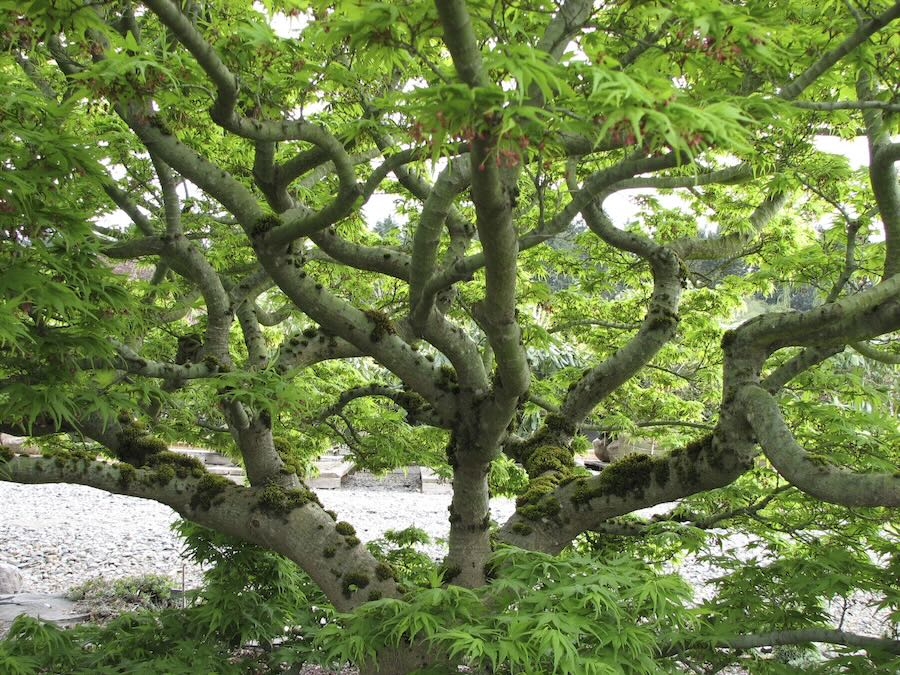
Now, what we do at our nursery is if we’re going to name something, we try to name the five closest things to it and say, is it better or worse than those things, and how? We have to be able to say, “It’s better than ‘Kuro hime,’” for these reasons.
And then, we want to watch it for seven years, put it in some different places—send one to Oregon, send one to New Jersey, send one to Florida—and see what’s going on with that tree over a longer period of time, grafted, so we can evaluate it to make sure we’re not just reintroducing. We don’t want to reinvent the wheel here. We’ve already got things that are great and we don’t really need another one unless it has a good reason to be.
We like that. But we also like to do cutting-edge stuff. Here at our nursery, we’re always looking for fun and interesting things, and we try to break the mold for what can be done. We like those rule-breakers. We like things that are other species that are interesting, like the oliverianum Tim was talking about.
One of the holy grails for a while for nurseryman has been a really nice redder form of ‘Mikawa Yatsubusa’ [above, a historic specimen at Buchholz Nursery]. We’ve recently came out with one that’s been our best. We’ve been through about 2,000 or so red Mikawa seedlings since around 2008. We start evaluating them and we just grade them. We’ll go through and grade, and go, best one, best one gets planted, and then the rest just get sold off for seedling sometimes. They can be great plants, but they don’t deserve cultivar status.
We’ve recently released one called ‘Red Panda’ that’s been a big hit for us. That’s kind of been a holy grail for a lot of people. I think the name’s fun, too. I was looking at a red panda with my kids at one of our local nature centers here. They have a native animals exhibit and they have this one animal, it’s the red panda. And so, my kids absolutely love the red panda here locally and said, “That’d be a perfect name for that red ‘Mikawa Yatsubusa’ we have.” People have been really crazy about that one. The hype’s been really high on that one [laughter]. It’s been one of our most recent holy grail types to release.
Margaret: Cool. Well, Matt and Tim, I’m so glad to speak to you as always, and it was fun doing the “Times” story together. I wish you the best with all the transition with Buchholz Nursery and all the other things you’re doing. I saw you on Instagram planting daylilies the other day, so I’m assuming MrDaylily dot com is next, because you’re so crazy [laughter]. But thank you so much for making time today.
Matt: Tim and I actually, I bought my first car and he bought the first family computer working at daylily farms, so I guess we’ve always been crazy hoarders of plant. We’ve always had the bug for something. I’m just so honored you had us on. Thank you so much, and for the article and just everything. We’re just humbled and honored whenever anybody wants to talk to us about plants, and we’re still shocked every time they do.
Margaret: Well, good. I’ll talk to all of you again soon.
(All photos from Buchholz Nursery and MrMaple.)
more from mrmaple
prefer the podcast version of the show?
MY WEEKLY public-radio show, rated a “top-5 garden podcast” by “The Guardian” newspaper in the UK, began its 15th year in March 2024. It’s produced at Robin Hood Radio, the smallest NPR station in the nation. Listen locally in the Hudson Valley (NY)-Berkshires (MA)-Litchfield Hills (CT) Mondays at 8:30 AM Eastern, rerun at 8:30 Saturdays. Or play the April 8, 2024 show using the player near the top of this transcript. You can subscribe to all future editions on iTunes/Apple Podcasts or Spotify (and browse my archive of podcasts here).


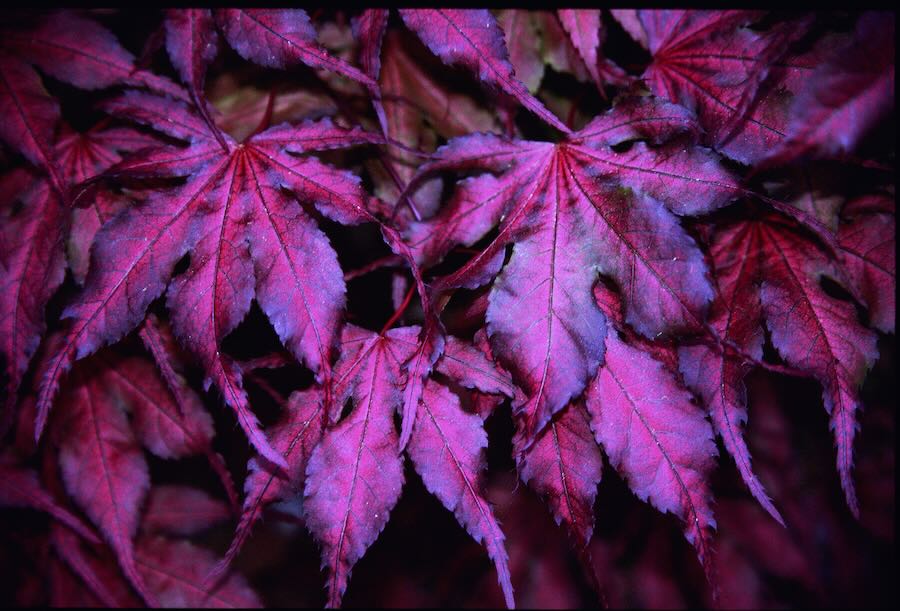
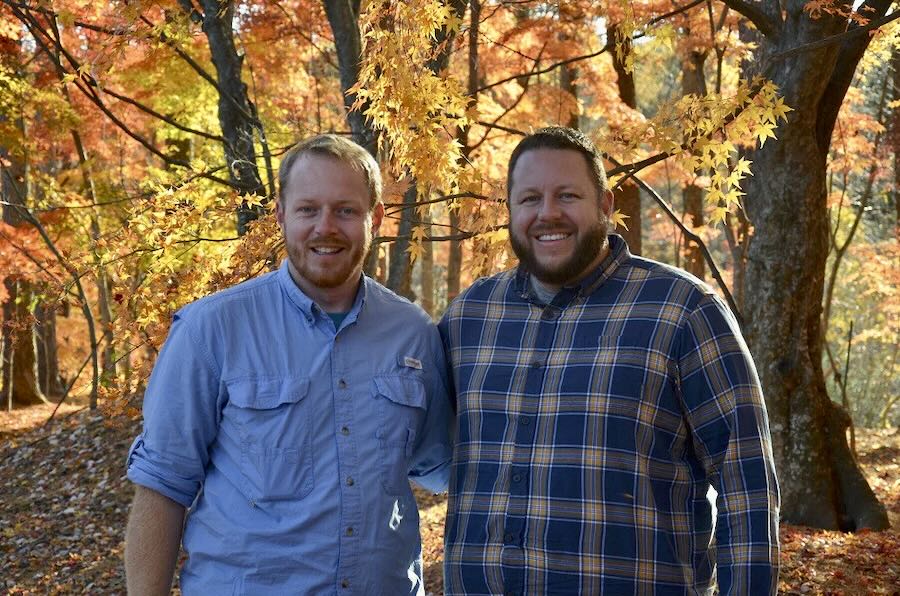 japanese maples, with the nichols brothers
japanese maples, with the nichols brothers